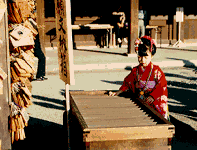Shinto Shrines
To the casual observer, it is difficult to tell the difference between Shinto shrines and Buddhist temples. The easiest way to distinguish between the two is that when you enter a shrine, you pass through an arched torii gate. The gate has two vertical pillars with two horizontal crossbeams. Both shrines and temples are usually made up compounds which can cover a large area and include many different buildings. But many shrines, especially in urban areas, are very small and easily missed by a passer-by. There are about 90,000 shrines in Japan and they provide a focal point for both urban and rural communities. Shinto rites such as weddings, festivals and purification rites are often held at the local shrine. The more popular shrines, such as Meiji Jingu in Tokyo, Tsurugaoka Hachiman in Kamakura and Yasaka Jinja in Kyoto, are literally mobbed by millions of visitors during the New Year holiday. Hatsumode is the first shrine or temple visit of the year and the crowds gather from midnight on New Year's Eve.
In Shinto, the central concept is that of the kami, a spirit or god. Almost every natural object or phenomenon can be inhabited by a kami and so things such as volcanoes, rocks, waterfalls, forests or even individual trees can be considered sacred. The sacred area is indicated by a shimenawa (straw rope) around it, often with strips of white paper attached.
While many shrines are very ancient, often the buildings themselves are much newer. Fire and natural disaster are the main reasons but many shrines had a tradition of reconstruction to purify the site and building materials. The Ise Jingu shrine still keeps this tradition and is rebuilt every 20 years.
The three major shrine centers are at Ise on the Kii Peninsula, Nikko (an hour from Tokyo) and Izumo Taisha in western Honshu.

A stone torii gate and lanterns stand amid rice paddies at the entrance to a rural shrine.

A young kimono-clad girl makes an offering at Meiji Jingu shrine in Tokyo.
Shrine Layout
The larger area of a shrine is enclosed by a wooden fence with a torii at the entrance, usually at the farthest point from the honden (main sanctuary). A path or set of steps leads into the compound, sometimes arched by more torii - the two paths in Fushimi Inari shrine in Kyoto are lined by 10,000 torii! There is usually a lot of greenery and trees lining the path and throughout the compound. At the end of the path you will often see a pair of guardian figures - a and un - called komainu (mythical lionlike dogs) of which one has its mouth open in a roar. Off to the side is a temizuya, a small pavilion for washing your mouth and hands to purify them. In the case of popular shrines, there is an office selling lucky charms and omikuji, a kind of fortune-telling. If the paper fortune is unlucky, it is tied to a nearby tree in the hope that the kami will see to it that it doesn't come true. This lucrative business is especially popular around the time of school and university entrance examinations. There may also be a kaguraden (hall of sacred dance and music) where kagura (dances or rituals) are held as part of the shrine's annual festival.

In front of the honden is the haiden (oratory or hall of worship) where offerings are made and rituals carried out. In a typical shrine visit, worshippers stand in front of the haiden, clap their hands and tug a rope attached to a bell to announce their arrival to the kami. They then put their palms together in front of their chin, make a short prayer and put a money offering into a slatted wooden box. Lay worshipers are rarely allowed to actually enter the haiden. The honden houses the shintai, the sacred object which the kami inhabits. It is off-limits except to priests, and even then only on rare occasions. In some cases, while the haiden is easily accessible, the honden may be located on a distant mountain top or may even be the mountain top itself (or other natural feature).
Related topics:
